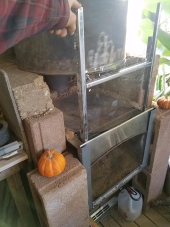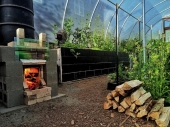
 7
7












 3
3




 6
6




I make a Maple Syrup instructional movie! Check it out HERE
SKIP books, get 'em while they're hot!!! Skills to Inherit Property
See me in a movie building a massive wood staircase:Low Tech Lab Movie
 4
4




 1
1




 4
4




Where there is Liberty, there is Christ!
 2
2




You should never forget that every creature has its purpose in the cycle of nature and can also be very important to humans. Sepp Holzer's Permaculture
 1
1




 1
1




“The most important decision we make is whether we believe we live in a friendly or hostile universe.”― Albert Einstein
 1
1




 1
1




William Bronson wrote:This makes me want to experiment.
I picture waxed cardboard and/or pallet wood as inner forms for a bench or bell, with pallet wood as the outer forms and tamped soil in between.
Install your rocket or TLUD to charge the mass with heat.
Anything that get hot enough can burn out, whatever is left is fine.
 1
1




T Blankinship wrote:I was thinking that if you had cinder blocks that could take the heat. Could one build a mass in the shape of a wall?
 2
2




I make a Maple Syrup instructional movie! Check it out HERE
SKIP books, get 'em while they're hot!!! Skills to Inherit Property
See me in a movie building a massive wood staircase:Low Tech Lab Movie
 3
3




John Weiland wrote:Really liking this vision! If heating the bricks is not a problem, would it be possible to lay the design that you presented on its side so that you could add a second layer off bricks to serve in heat dissipation? In this scenario, the flow of exhaust would be side-to-side, similar to many builds that are put into a gravely matrix. With perhaps a high temperature flexible exhaust tube, it could be snaked through the cells of the cinder block to help bring the exhaust to its destination without having to worry about sealing the gaps between the bricks. With two layers of bricks oriented as shown below, the bench would be wide and sturdy enough to be sat on without tipping. Just some musings....
Where there is Liberty, there is Christ!
 3
3




 2
2




Glenn Herbert wrote:Burlap soaked in clay slip would be such a thin layer that it would be irrelevant, though I don't think it would be necessary either as long as there was cob covering everything. You want some straw in the cob, especially the outer couple of inches, to stop drying cracks from widening. You would want as many rocks as you can fit inside the mass, and the cob serves to fill the gaps between stones for continuous conduction. Obviously the denser the rocks you can find, the better.
Minimizing storage in your heat transfer medium means that you will have very hot radiating surfaces which you will not want to touch. Conduction is the most efficient form of heating; radiation to remote surfaces works but is not as efficient. The hotter the radiating surface, the stronger the convective plume of hot air will be, rising to the ceiling where it does little good.
If you are starting with rammed earth, thermal cob (with no straw) is practically the same thing. Structural cob with straw reinforcement is not much different as long as you don't go overboard with the straw.
 1
1





 3
3




For all your Montana Masonry Heater parts (also known as) Rocket Mass heater parts.
Visit me at
dragontechrmh.com Once you go brick you will never go back!
 3
3




 2
2








 3
3




For all your Montana Masonry Heater parts (also known as) Rocket Mass heater parts.
Visit me at
dragontechrmh.com Once you go brick you will never go back!
 1
1




 1
1




Toko Aakster wrote:My biggest concern for a design like this (zig-zagging pipes) in a permanent structure is: How do you clean it out?
Chimneys are supposed to be cleaned out 1x per year.
This is because Creosote builds up in the chimney flue during use.
Creosote being the various tars and charcoals from burning plant materials like wood. If smoke exiting a chimney is cools to below 250 degrees Fahrenheit, the gasses liquefy, combine, and solidify to form that tar compound.
While /theoretically/ A properly functioning RMH won't create much Creosote, there are a thousand little ways that dimensions can be off, or someone uses wood that isn't completely dry, they let the embers smoulder as they go out instead of extinguishing it right away, or just the trace amounts that happen during the normal start-up period before the 'rocket' part kicks in fully. There's a bunch of other what-if scenarios that would result in Creosote forming inside the RMH and pipes despite our best efforts, during habitual use.
Creosote, even only 1/8th of an inch (0.3 cm) of buildup can ignite at temps as low as 451 degrees F (232 C) and burn at temperatures in excess of 2,000 degrees F (1093 C) those high temps can melt mortar and damage even firebrick, which is only meant to withstand temps up to 1,700 degrees F. (926 C)
The primary Anti-creosote / creosote-removing product that I know of uses acetic acid (you can dehydrate it out from vinegar), which is highly corrosive to metal, including stainless steel. It's fine for brick, but would not be friendly to rocket-mass heaters which use metal components. Additionally, its use requires the user to reach in and manually scrub the Creosote to remove it, after treatment. Having tight elbows & long channels would make cleaning very difficult.
So: great idea for something with only 1 bend, where each length of tunnel can be accessed from either the entrance port or the exit chimney, but more bends which are inaccessible to clean /when necessary/ would make me leery.
Short-term use structures would also be fine, but I wouldn't want to make a wall of my house out of a bunch of zig-zagging no-access tunnels.
Edit to add:
From Peter van den Berg's posts about using a batchrocket heater, he had a chimney sweep come and clean it one time after 7 winters of using it. He reported the chimney sweep said the amount of creosote that was cleaned out was "not much for a whole burning season"
So, cleaning would still be necessary for these systems, even if it's very infrequent. (once every 5-10 years).
This is an excellent maintenance timeframe for a home heater, but a wall of multiple zig-zags would still have to be dismantled somehow to properly clean it.
I see the claim "There is no creosote deposits from rocket stoves" - but this is demonstrably not accurate.
There is a much smaller amount of creosote buildup compared to a regular wood stove / fireplace, but it is not 'nothing'. It still requires routine cleaning to prevent an internal fire, when the creosote actually does ignite & starts melting things.
Kinda like how the ductwork in your home HVAC system needs to be cleaned every 3-5 years or so, even if you have good filters. No system is perfect.
It is low-maintenance, but not 'No Maintenance'
So, accessibility to clean is something to take into consideration when installing.
 2
2




thomas rubino wrote:Hi Toko;
Good points.
You have a few numbers a bit off such as, most firebrick is rated for 2500F not 1700F although some insulated firebrick are rated at 1700F
The original poster is just experimenting and trying different ideas.
The following posters are just elaborating on his thoughts. Brainstorming so to speak.
I mean, a plastic pipe as a riser would make a spectacular candle if it ever got hot!
If you want to see terrible ideas, cruise "youtube" and check out the things some people try...
We call them flaming units of death! Rarely do you see follow-up videos of how great their new design RMH is doing.
My thought is they are too busy cleaning up the mess...
An RMH that is built even close to specifications will always burn hot enough in the riser to incinerate volatiles like creosote.
What can collect in the pipes of an RMH, is very light nonflammable fly ash.
A poorly built RMH can plug your horizontal pipes up in just a few months with fly ash but not creosote. (ask me how I know this)
Creating a piped system of any design without cleanout access is a very poor idea.
I have used a leaf blower to blow out a system in the past. Other than the new mess you create outdoors it will work. (see the previous statement)
Typical horizontal pipe temps run at 250F or less.
The bottom line is plugging your horizontal with ash is the biggest concern, as it prompts the fire to exit the feed tube rather than the riser.
 6
6








 6
6




For all your Montana Masonry Heater parts (also known as) Rocket Mass heater parts.
Visit me at
dragontechrmh.com Once you go brick you will never go back!
 3
3




If there is one thing the Wizard of Oz has taught me, it is not to trust school teachers on bicycles.
 2
2




thomas rubino wrote:Hey Nick;
Those light pumice bricks are true cinder blocks, the others are concrete blocks.
The concrete blocks will work as a tunnel through the mass.
You could forego the tunnels altogether and create a bell/bench instead.
As you are in Guatemala rather than Montana or Alaska you can experiment much easier than us folks up in the snow country.




 3
3




For all your Montana Masonry Heater parts (also known as) Rocket Mass heater parts.
Visit me at
dragontechrmh.com Once you go brick you will never go back!
 3
3








 2
2




For all your Montana Masonry Heater parts (also known as) Rocket Mass heater parts.
Visit me at
dragontechrmh.com Once you go brick you will never go back!
 2
2









|
And tomorrow is the circus! We can go to the circus! I love the circus! We can take this tiny ad:
The new purple deck of permaculture playing cards
https://www.kickstarter.com/projects/paulwheaton/garden-cards
|





